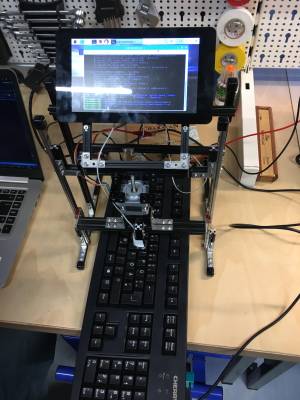**Dies ist eine alte Version des Dokuments!**
A non-invasive approach for measuring input device latency
Latency measurement is no new research area but has ongoing relevance to users of input devices. As this number is not decreasing, we investigate a new approach. Bockes, Schmid and Wimmer [1] described an invasive way to measure input latency of different types of devices. We pick up their idea by doing the same with a non-invasive approach. Which means, that we focus on pressing a button of USB-connected input-devices to trigger an input-event and measure the time it takes to arrive at the system.
Members: Paul Winderl, Johannes Dengler, Thomas Oswald
Keywords: WIP, measuring, user study, input device, latency
A non-invasive approach for measuring input device latency: Method for input device latency measurement without irreversibly damaging the device.
This research project examines a way of non-invasive measurement of input device latency. To achieve this, we try to measure the pressure point of a input button and repeat a clicking mechanism to get latency data. After collecting those, we compare the result with an invasive approach that was used in a previous study.

Goals
The goal of this project is to examine the possibility of non-invasive latency measurement. We use an existing prototype that is to be enhanced by us.
A last approach used an invasive method to measure latency. This was done with the LagBox and a wired connection to the hardware of input devices [1].
However, invasive techniques are always connected with expense, time exposure and possibly an unrepairable hardware. Our approach tries to address these issues.
We are starting with an pressure sensor connected to a motor and a Raspberry Pi. The measurement works as follows: The sensor will be moved onto a button of a input device until it hits the pressure point which indicates a button press. We try to find this point and measure its latency from press to incoming signal at the usb driver.
Updates
Final Implementation and Measurements (2019-02-18)
This time we implemented last modifications and measured a couple of devices with this new software. Furthermore, we compared our solution with the PusherBox of another group. (more...)
More Testing (2019-02-04)
We are testing our calibration processes and overall measurement with different approaches. (more...)
Calibration, Measurement and Logging Files (2019-01-14)
Implemented functions for logging handled by two threads. (more...)
Testing and adjusting the calibration + a little gui (2018-12-18)
In this two weeks we have completed a new iteration of our calibration up and running. In a testing session we found minor enhancements and thought of a future roadmap. Furthermore, our GUI is still in development. (more...)
Implementation of the calibration process (2018-12-04)
Pressure point is now determined and tested for calibration. (more...)
The beginning of a life full of researching (2018-11-21)
This first article will inform about our start, the approach we take, our current status and a short outlook. (more...)
Further Resources
Literature [1] Bockes, F., Wimmer, R., & Schmid, A. (2018). LagBox – Measuring the Latency of USB-Connected Input Devices. In Extended Abstracts of the 2018 CHI Conference on Human Factors in Computing Systems (S. LBW115:1–LBW115:6). New York, NY, USA: ACM. https://doi.org/10.1145/3170427.3188632 [2] Manfrotto 035 Superclamp Universal Befestigungs-Mechanismus (Aluminium) schwarz. (n.d.). Retrieved January 17, 2019, from https://www.amazon.de/Manfrotto-Superclamp-Universal-Befestigungs-Mechanismus-Aluminium/dp/B000JLM4XG/ref=sr_1_6?s=ce-de&ie=UTF8&qid=1547708046&sr=1-6&keywords=fotoklemme